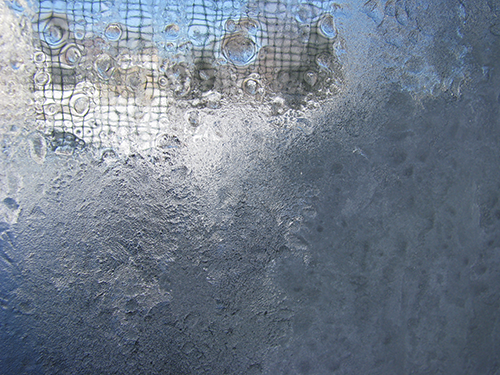
Condensation or frost in your attic means that you are losing money in heating costs, and that your home is at risk of developing some expensive problems related to frost and moisture build up, and to ceiling damage.
Like ice damming, the formation of condensation or frost in the attic is related to the insulation, vapour sealing, and ventilation in your attic. While the formation of an ice dam can be caused by an inadequate thermal barrier between the interior of the house and the underside of the roof, condensation in the attic is caused by the flow of actual humid air from the interior of the house into the attic, not just heat.
Warm, moist (relative to the outside) air from inside your home leaks up into your attic, and condenses into water droplets or frost when it comes into contact with the underside of the roof. These droplets stick to the roof boards, and can cause the wood to break down prematurely, or allow mould to grow, which can be a health hazard for your home’s occupants.
If the humidity level of your home is too high, you will likely have problems with condensation in your attic. What is the recommended level of humidity of a Winnipeg home in winter? When the outside temperature has been averaging -25 C (-13 F) for several weeks in a row – what we would consider the “dead” of winter – your indoor humidity level needs to be about 20%. Humidity can be measured with an inexpensive digital hygrometer, available for around $20 at most home-supply stores.
To check for a condensation problem in your attic, you need to venture there (or have someone else do it for you). Examine the underside of your roof. If the temperature is above 0° C, look for moisture on the underside of the roof sheathing, or on the tips of the nails that protrude through. If it’s below freezing, you’ll see frost. Water stains that are small (1 or 2 feet in diameter) are symptoms of roof leakage, while large ones (3+ feet in diameter) are usually caused by condensation.
If there’s condensation in your attic, you are wasting energy heating your home, resulting in elevated fuel costs. You’re also likely to experience ice damming, which destroys your roof materials, your eavestroughs, and allows water into your home. Condensation can also manifest itself within exterior wall cavities, as frost on foundation walls or joist header areas, and as mould on the inside of exterior walls or along the ceiling-wall intersection.
Contact Above All Roofing & Exteriors for an expert evaluation, including a humidity check of your home and possible thermal imaging of your attic and walls. Your evaluator can also discuss with you possible options for lowering your indoor humidity level.